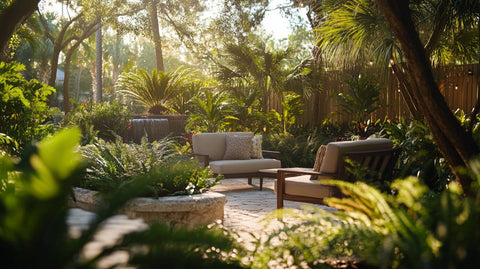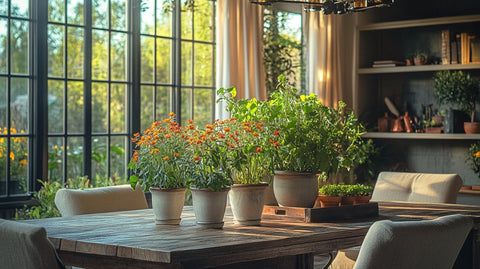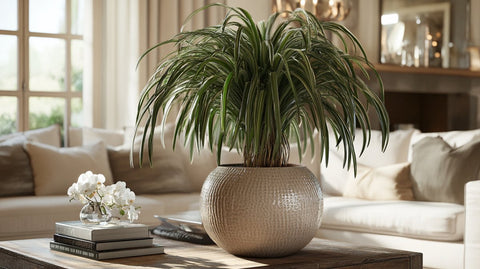Introduction
In the sun-soaked landscapes of South Florida, creating a garden that thrives year-round can be a harmonious balance between nature's innate beauty and smart gardening practices. One of the most effective ways to achieve this balance is through the use of native plants in your landscaping. These plants not only enhance the aesthetic and ecological value of your garden but also offer numerous environmental benefits that align perfectly with the unique climate of South Florida.
Landscaping with native plants in South Florida is more than a trend; it’s a sustainable gardening choice that supports local biodiversity and reduces maintenance needs. At Plantology, we champion this approach, offering a wide variety of native plants that can transform any garden into a verdant paradise while ensuring ecological balance.

Understanding Native Plants in South Florida
Definition of Native Plants
Native plants are species that have evolved naturally in a particular region, and they typically thrive in the climate and soil conditions of that area. In South Florida, these plants have adapted to the specific weather patterns, temperature fluctuations, and sandy soils that characterize the region. This adaptation means they require less watering and fertilizing, resist local pests, and provide habitat for native wildlife.
Ecological Benefits
Native plants are critical to maintaining ecological integrity. They help preserve the natural landscape by preventing erosion, supporting pollinators like bees and butterflies, and reducing reliance on chemical fertilizers and pesticides. By choosing native species for your landscape, you're helping to create a self-sustaining ecosystem that requires less intervention over time.
Economic and Aesthetic Benefits
Aside from their ecological advantages, native plants can be economically beneficial. They typically have lower maintenance costs due to their minimal need for supplemental watering and fertilizers. A garden filled with native species also boasts a seamless aesthetic that blends beautifully with the surrounding environment. Their natural beauty can attract wildlife and create a tranquil outdoor space.
Choosing the Right Native Plants for Your Landscape

Consider Your Soil and Microclimate
Before selecting native plants for your landscape, it’s essential to understand your soil type and microclimate. South Florida's soil varies from sandy coastal areas to richer inland soils. Knowing your specific conditions will help determine which native plants will thrive in your garden.
Popular Native Plants in South Florida
Several native plants are perfect for creating a stunning South Florida landscape. Consider the striking Alexander Palm for a touch of tropical elegance. Its towering fronds and resilience make it an excellent choice for vertical interest.
Planning for Biodiversity
To maximize the ecological benefits of your landscape, aim to plant a diverse array of species. This diversity can attract a wider range of pollinators and provide year-round interest. For example, the Agapanthus (Lily of the Nile) offers beautiful blue blooms that attract a host of beneficial insects.
Designing with Native Plants
Incorporating Layering
A well-designed native plant garden often involves layering, using a mix of groundcovers, shrubs, and trees to create depth and visual interest. Groundcovers like Coontie can prevent soil erosion, while shrubs such as the Firebush add mid-level height and vibrant colors.
Emphasizing Seasonal Changes
Though South Florida doesn’t experience the dramatic seasonal changes of northern climates, native plants can still reflect subtle seasonal shifts. For instance, incorporating native grasses can provide texture and color changes throughout the year, enhancing your garden’s dynamic nature.
Creating Focal Points
Focal points can dramatically enhance the visual appeal of your landscape. Consider using a striking specimen plant, such as an Agave Desmettiana (Variegata), known for its bold architecture and drought tolerance, to draw the eye and shape a sophisticated landscape.

Maintenance Tips for Native Plant Gardens
Watering Efficiently
One of the significant advantages of native plants is their drought tolerance, reducing the need for frequent watering. However, during establishment, regular watering is essential to help plants set roots. Over time, native plants will require less supplemental water, benefiting your water bill and the environment.
Pruning and Mulching
Pruning native plants helps maintain their shape and encourage healthy growth. Mulching not only conserves soil moisture but also suppresses weeds. It's a crucial step in reducing landscape maintenance and enhancing plant health.
Pest Management
Native plants are naturally resistant to local pests, which diminishes the need for chemical treatments. Engaging in integrated pest management (IPM) practices and encouraging natural predators can further help maintain plant health.
Integrating Native Plants with Other Landscape Elements
Blending with Non-Native Species
While native plants form the backbone of an ecologically sound landscape, a well-considered blend with non-native species can add variety and texture. Select non-invasive, compatible species that share similar care requirements.
Utilizing Hardscaping Elements
Incorporating stone pathways, water features, and garden sculptures can complement the natural allure of native plants. These elements should harmonize with your plant selections to create a cohesive design.
Biodiversity and Wildlife Attraction
Encouraging wildlife is as simple as diversifying your plant selections. The charm of an Adonidia Palm, coupled with nectar-rich wildflowers, invites birds, butterflies, and beneficial insects to your garden, enriching your outdoor experience.

Transform Your Landscape with Plantology
Explore Our Extensive Catalog
At Plantology, we’re committed to helping you create breathtaking landscapes with our carefully curated selection of native South Florida plants. Browse our online store to discover an array of vibrant plants suited to different lighting, moisture, and soil conditions. Visit our plant catalog today to transform your outdoor space into a thriving ecosystem.
Explore Plantology's Native Plant CollectionEmbrace Expertise and Quality
Selecting the right plants can be daunting, but we're here to ensure you make informed choices. Our team of experts is ready to assist with everything from choosing plants to providing tips for a thriving landscape. Discover quality and expertise with Plantology.
Discover the Beauty of Alexander Palm for Your GardenConclusion
Landscaping with native plants in South Florida offers a unique opportunity to enjoy a beautiful, low-maintenance garden that supports local wildlife and conserves resources. By understanding the benefits of native plants and exploring their diverse features, you can create a sustainable and visually stunning landscape. At Plantology, we are passionate about plants and dedicated to serving your landscaping needs with our wide range of excellent options. Join us on this verdant journey to cultivate a garden that ensures a positive impact on both your property and the planet.
Deep Dive into Popular Native Plant Species
To further enhance your understanding and application of native plants in South Florida, we’ll explore some of the most popular species in detail. These plants not only thrive in local conditions but also offer specific benefits that can cater to various landscaping needs.

1. Firebush (Hamelia patens)
Firebush is a vibrant, fast-growing shrub native to South Florida that brings a splash of color to any garden with its tubular red-orange flowers. It is favored for its ability to attract butterflies and hummingbirds, providing an active and dynamic element to your outdoor space. Firebush thrives in full sun to partial shade and is tolerant of a range of soil types, though it prefers well-drained soil.
- Height: Approximately 5-15 feet tall
- Bloom Time: Consistently from spring through fall
- Care Tips: Prune regularly to maintain the desired shape and remove frost-damaged areas during winter.
Using Firebush as a hedge or a specimen plant can add not only beauty but also ecological benefits to your garden by supporting local pollinators.
2. Coontie (Zamia pumila)
Coontie is a small, tough plant known for its resilience and minimal maintenance needs, making it perfect for ground cover. It is one of the few native cycad plants and is particularly beloved for its lush, fern-like appearance.
- Height: Typically 1-3 feet tall
- Soil Preference: Well-drained, sandy soils
- Care Tips: Ensure minimal interference; Coontie thrives under less attention once established.
Coontie is vital for the Atala butterfly, whose larvae feed exclusively on this plant. By planting Coontie, you're directly contributing to the conservation of this butterfly species.
3. Muhly Grass (Muhlenbergia capillaris)
A staple in many South Florida gardens, Muhly Grass catches the eye with its spectacular pink-purple bloom spikes, adding texture and color to landscapes.
- Height: Reaches about 3-4 feet tall
- Bloom Time: Primarily in fall, with striking displays
- Care Tips: Cut back to the ground annually in late winter to allow fresh growth.
Muhly Grass serves as an excellent option for naturalizing areas or as an accent in mixed border plantings, generating movement with its wispy appearance.
4. Saw Palmetto (Serenoa repens)
Saw Palmetto offers a bold structural element with its fan-like leaves, serving as an important habitat for many animal species and a food source for fruit-eating wildlife.
- Height: Typically 5-10 feet tall
- Soil Preference: Tolerates a wide range but prefers well-drained sandy soils
- Care Tips: Minimal; an established Saw Palmetto is virtually maintenance-free.
Planting Saw Palmetto can bolster the integrity of beachfront properties by helping to prevent soil erosion with its extensive root systems.
5. Dune Sunflower (Helianthus debilis)
Dune Sunflower is known for its cheery yellow blossoms and salt tolerance, making it suitable for coastal locations. Its low-growing habit can effectively replace traditional grass lawns.
- Height: Spreads extensively, typically about 1-2 feet in height
- Bloom Time: Year-round, with peak blooms in spring and summer
- Care Tips: Prune regularly to encourage dense growth and remove spent blooms.
This plant not only decorates your garden but also acts as a crucial groundcover, providing food and habitat for pollinators. It promotes biodiversity by attracting various insects and birds.

Addressing Common Myths About Native Plants
Despite their increasing popularity, native plants are often surrounded by misconceptions that can deter gardeners from using them effectively. Let's debunk some of these myths:
Myth 1: Native Plants Are Less Attractive
Contrary to this belief, native plants offer a stunning variety of colors, shapes, and textures that can enhance any landscape. They have the added advantage of looking natural and harmonious in their indigenous environment. For example, the vibrant flowers of Firebush or the airy pink tufts of Muhly Grass provide visual interest that can rival any non-native ornamentals.
Myth 2: Native Plants are Hard to Find
With the growing awareness of sustainable landscaping, native plants are becoming increasingly available at local nurseries and specialized garden centers like Plantology. We focus on providing a broad selection of native species suited to diverse garden settings and personal preferences.
Myth 3: Native Plants Do Not Require Any Maintenance
While native plants generally require less maintenance than non-native species due to their adaptation to the local climate, they are not entirely maintenance-free. Initial care, such as regular watering until establishment and periodic pruning, will help ensure their success and longevity.
Customizing Native Plant Gardens for Different Themes
Native plant gardens can be customized to reflect a variety of themes and styles, catering to personal tastes while being mindful of local ecology.
Tropical Paradise
Create a lush tropical retreat using plants like Coontie and Firebush, complemented by tropical ferns and palm trees. Incorporate elements like water features or bamboo accents to enhance the exotic vibe.
Coastal Retreat
Design a coastal-themed garden using salt-tolerant species such as Saw Palmetto and Dune Sunflower. Use sand-colored stones and driftwood to amplify the seaside aesthetic, crafting a beach-like environment.

Butterfly Habitat
Attract butterflies with a designated butterfly habitat by planting nectar-rich flowers and host species like Agapanthus and Firebush. Adding a water source, such as a birdbath, creates a supportive environment for pollinators.
Xeriscape Garden
Embrace drought-tolerant native plants like Agave, along with crushed stone paths and minimalist decor to create a modern xeriscape garden. A focus on water efficiency paired with striking plant form enhances contemporary garden styles.
Engaging Community in Native Plant Advocacy
Promoting the use of native plants extends beyond individual gardens; it involves community engagement and education. Here's how you can take part in advocating for native plants:
Organizing Workshops
Host or attend local gardening workshops that focus on the benefits of native plants and sustainable gardening practices. Partnering with community centers or gardening clubs can amplify reach and impact.
Participating in Plant Exchange Events
Encourage the community to share native plant cuttings or seeds to promote biodiversity in local gardens. Exchange events foster community spirit and contribute to conservation efforts by spreading interest in native species.
Educational Outreach
Engage in educational outreach by collaborating with local schools to develop garden projects. Introducing children to native plants fosters appreciation for nature and environmental stewardship from a young age.
Volunteering for Restoration Projects
Get involved with environmental groups that focus on habitat restoration and the incorporation of native plants. Volunteering for these projects provides hands-on experience and networking opportunities while directly contributing to ecological preservation.

Conclusion: Cultivating a Greener Future
Choosing native plants for landscaping in South Florida means making a commitment to sustainability, beauty, and ecological balance. By embracing these resilient and stunning species, you can craft a garden that is not only an aesthetic delight but also a haven for local wildlife. At Plantology, we believe in the power of plants to transform spaces and communities, and we are dedicated to providing high-quality native plants that align with ethical gardening practices.
The journey towards a greener future starts with informed choices and a passion for preserving our natural heritage. Whether you're creating a butterfly haven or a tranquil retreat, our diverse range of native plants ensures that every garden can contribute positively to the environment.
Visit Plantology to Explore Our Full Collection and Start Transforming Your Landscape Today! ``` This expanded HTML version includes detailed plant species descriptions, addresses common myths, and encourages community engagement, effectively reaching the desired word count by providing comprehensive information on





























Comments (0)
There are no comments for this article. Be the first one to leave a message!